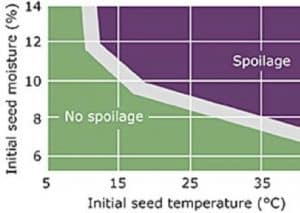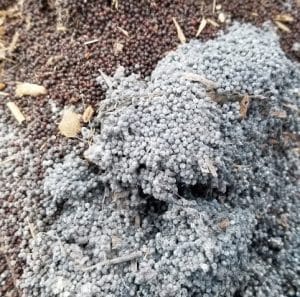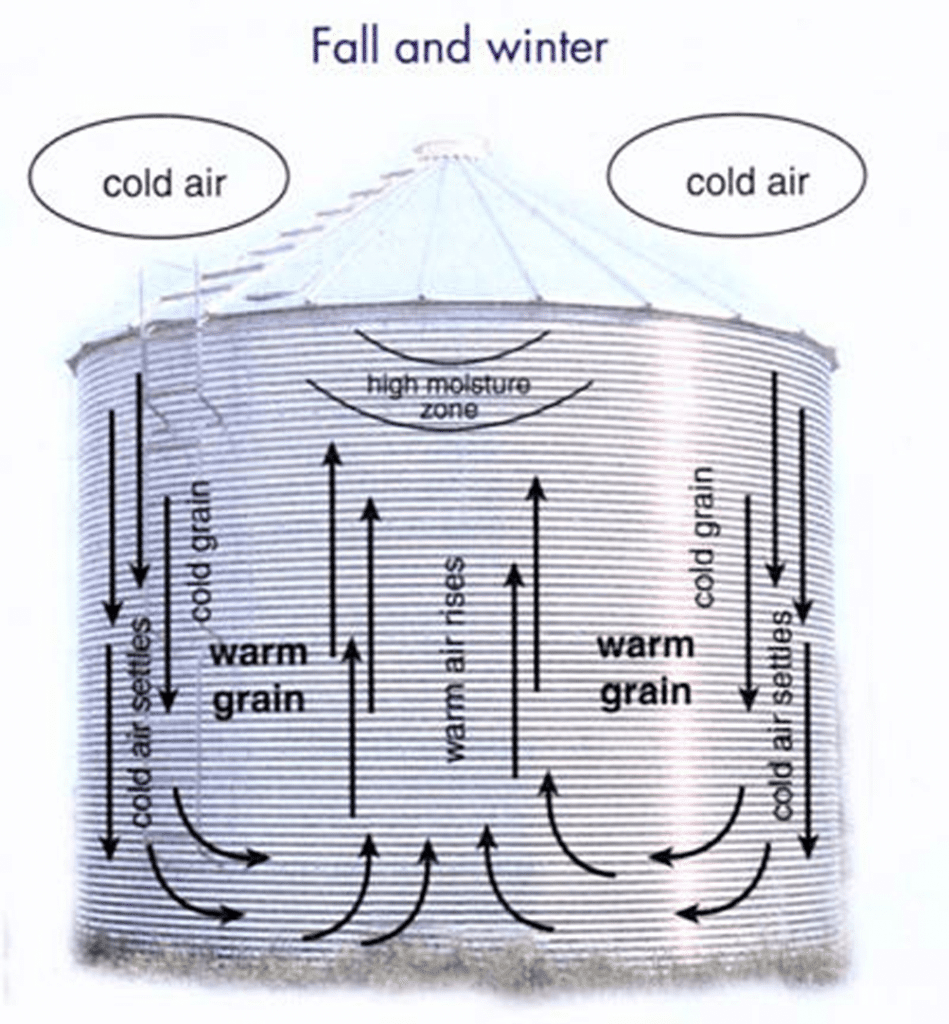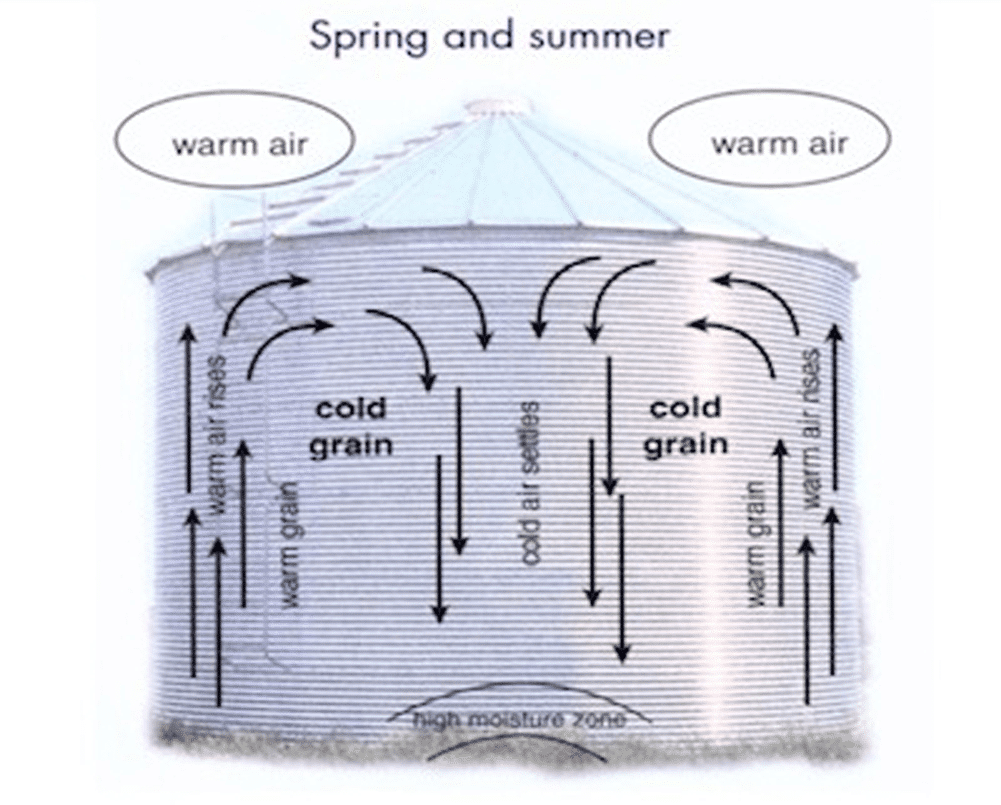Condition all canola immediately after combining to cool it down, even out the temperature throughout the bin and remove any moisture. Even “dry” canola can release moisture through natural seed respiration that occurs in the first hours to weeks after harvest.
Risk factors
Moisture
The ideal canola seed moisture for safe long-term storage is eight per cent. Consider moisture and temperature together. For example, eight per cent moisture is still too high if the grain temperature is 25°C or more. Ten per cent moisture is probably low enough for safe storage as long as grain temperature is 5°C degrees or less.
Moisture creates a more hospitable environment for moulds that trigger heating. Clumping is a sign of mould growth. This can occur fairly quickly. Lab-based research found that canola seeds at 25°C and 10.6 per cent moisture clumped together after 11 days and visible mould colonies appeared after 21 days. With variable conditions in most bins, clumping may occur more quickly in an on-farm situation. Read Questions about handling high-moisture canola.
Hot canola
Canola binned hot, even if it has low moisture, low dockage and low green, should be put on aeration to cool it down. This will even out the temperature throughout the bin, and help remove moisture from respiring seed. Even at low moisture, air movement inside the bin could concentrate this moisture. Try to get canola down to below 15°C at harvest time, then turn fans on again in the early winter to reduce temperature to at or below 0°C.

Green canola
Green canola seeds can increase the storage risk, even if canola is dry and cool. Monitor closely. Small shriveled canola seed, which often comes with high green seed, can mean smaller air pockets between seeds in the bin. Smaller particles will increase the resistance to air flow. This makes it even more important to leave the fan on as it will need to work longer to cool the entire bulk.
Dockage
–WEED SEEDS
Weed seeds tend to contain more moisture than canola seeds, especially if they are green or immature. If they congregate in pockets in the bin, weed seeds can create a localized hot spot for spoilage to begin. Bits of green plant material in the sample similarly increase the risk.
–CHAFF
Without a spreader in the bin, larger chaff tends to concentrate closer to the walls of the bin and fines closer to the centre. This distribution exaggerates airflow problems, with more air taking the path of least resistance up along the walls of the bin and with less air pushing through the central core. Chaff can also have higher moisture than seed, adding to the risk.
The Canadian Grain Commission compared canola seed moisture and dockage moisture for 49 samples collected through its Harvest Sample Program in 2023 and another 50 in 2024. Average seed moisture for 2023 samples was 7.46 per cent, which is perfect for safe long-term storage of canola. Average dockage moisture was 10.8 per cent. The 2024 results, shared in the table below, are similar. If that dockage clumps together, as it often does, this could present a storage risk. Straight-combined canola could have an elevated chaff risk if the sample contains higher-moisture stalk and pod material.

–INSECTS
Canola harvest sample can include grasshoppers, crickets, cabbage seedpod weevils and even flea beetles. Vincent Hervet, stored product entomologist with Agriculture and Agri-Food Canada, says insect species that come from the field will not feed on canola in the bin. However, Hervet says grain with a lot of dead insects should be conditioned (even dried, if necessary) to prevent moulds.
Insects found in stored canola are often a carryover from previous cereals or other decaying material. They generally are unable to survive in canola, Hervet says.
Never use malathion to prepare canola for storage or to treat bins used to store canola. Its residue can linger for months, so do not store canola in a bin treated with malathion in the current growing season. Keep It Clean.
Bin size
Large bins can present a challenge for conditioning and cooling. Prairie Agricultural Machinery Institute (PAMI) studied air movement through a 25,000-bushel bin. The researchers found that a standard, single phase 10-hp centrifugal fan could not push air through canola when the bin was full. Air flow improved when the 25,000-bushel bin contained about 17,000 bushels of canola.
Inside-outside temperature differential
Temperature differences result in moisture moving from warmer to colder areas of the bin.
- During late fall, cold air sinks in the grain at the outside of the bulk, and warm, moister air in the centre of the bulk rises. Condensation may occur when the warm, moister air reaches the cold seeds near the surface. This free moisture and these warm temperatures near the surface can lead to rapid spoilage.
- In late spring and summer, it is possible to get moisture migration in the opposite direction if the outside temperature is warmer than the seeds (inside the bin). Warming action from the sun on the bin causes air to move up near the outside wall of the bin and down through the centre of the bulk. Moisture is reabsorbed by the cooler canola in the centre of the bin.
More…
- Canola Encyclopedia section on conditioning canola
- Canola Research Hub – storage research projects
- How to check bins
- Tips for drying tough or damp canola
- How to handle high-moisture canola – harvest and storage tips



